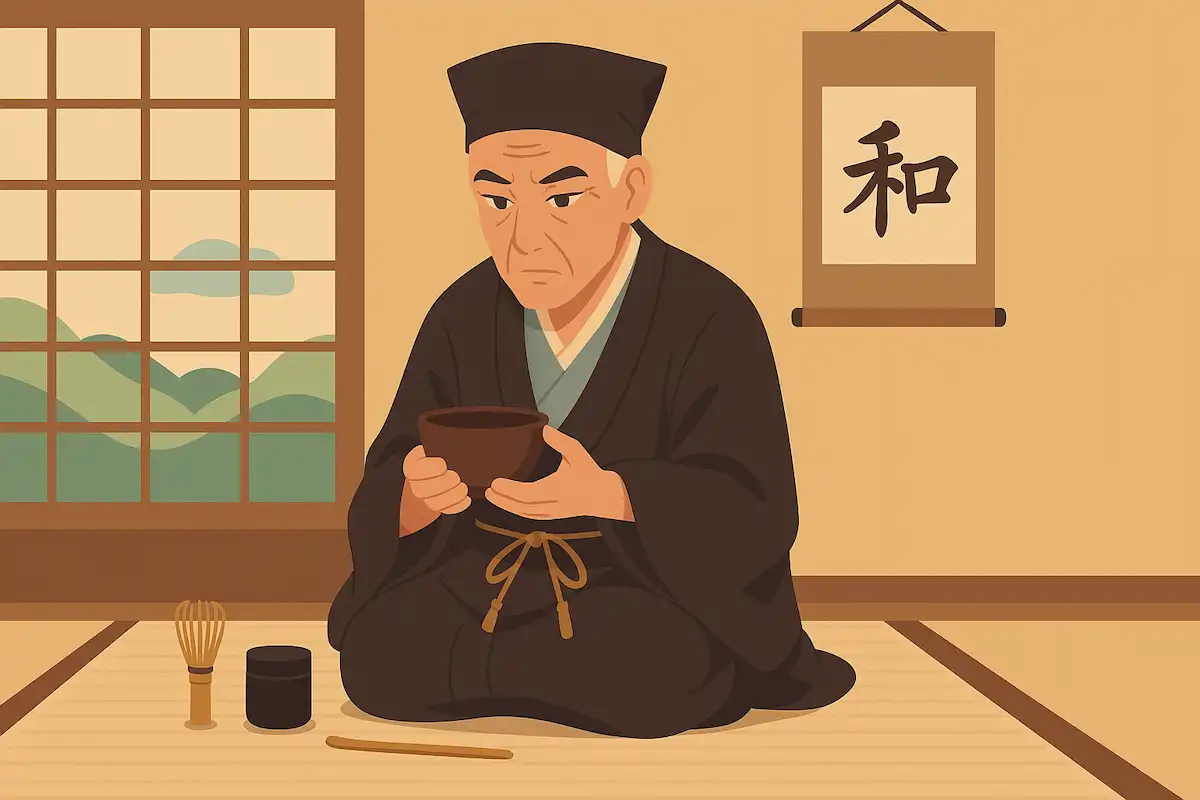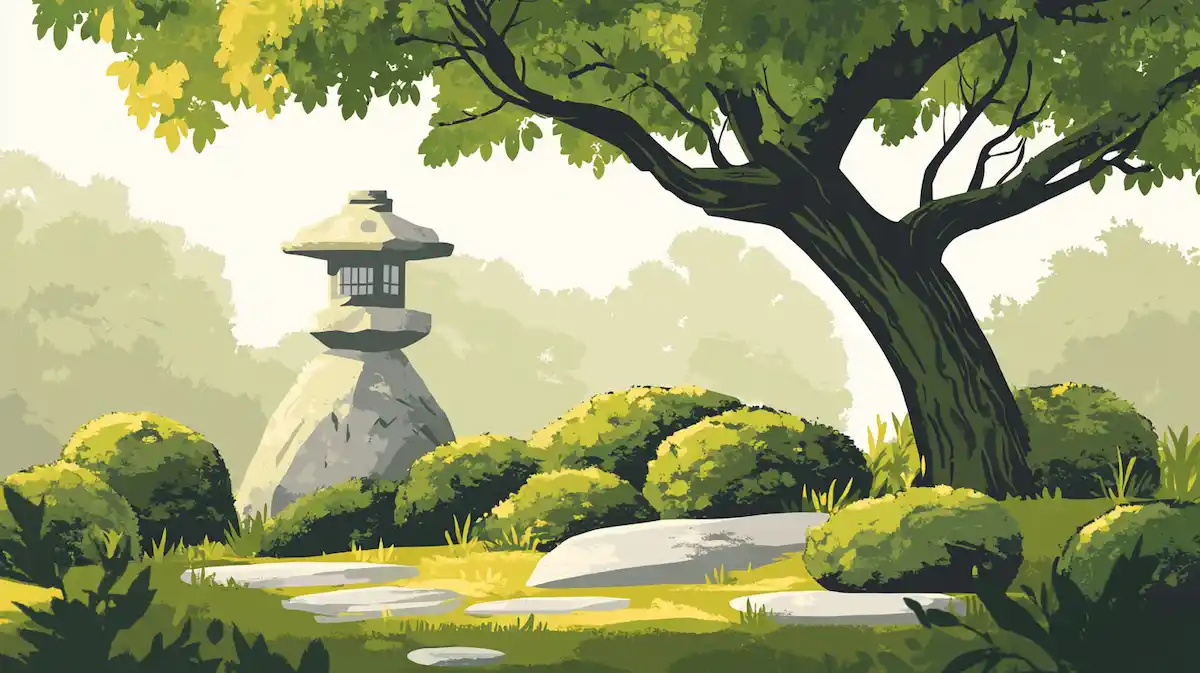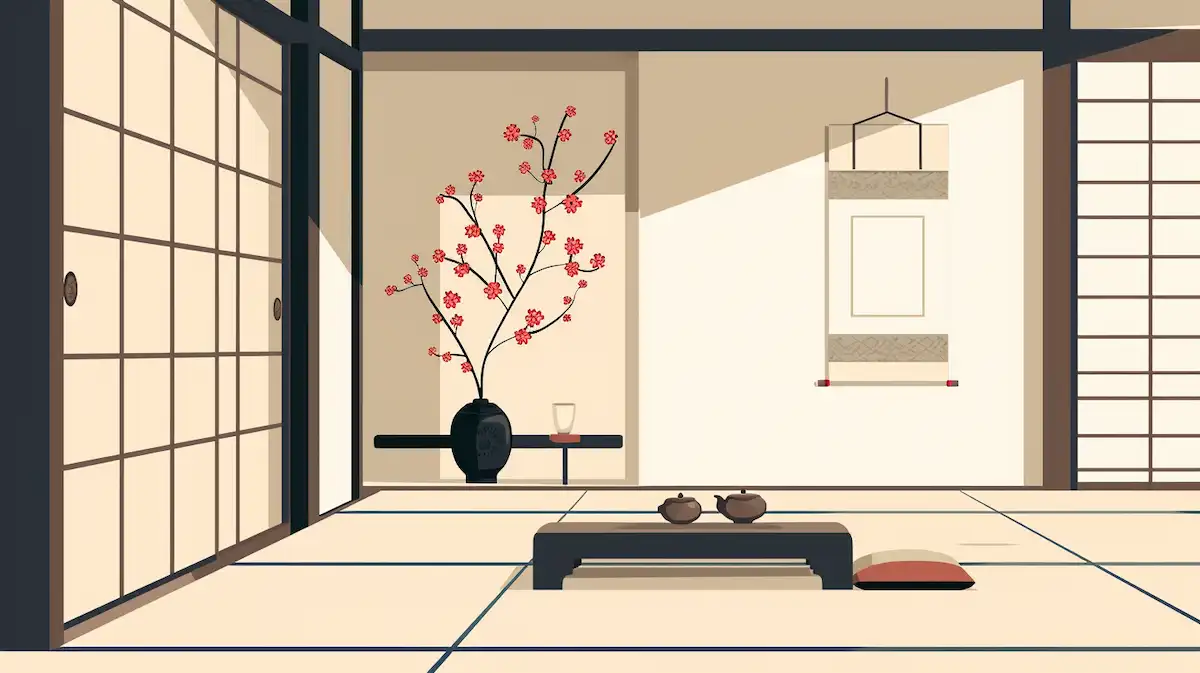茶道を英語で説明・紹介するための基本情報と、英会話に役立つ表現をシンプルでわかりやすい英語で紹介します。
英会話ダイアローグ・概要・10の質問・詳細情報を通して、茶道に関する英語表現を学びます。
英語
英会話ダイアローグを読む前に知っておくと良い前提知識と情報は以下の通りです。
- 茶道とは
- 日本の伝統的な茶を点てる儀式であり、単なる飲み物の提供を超えた深い精神性と美学を含む総合芸術
- 基本理念
- 茶道は「和敬清寂(わけいせいじゃく)」という理念に基づいており、調和(和)、敬意(敬)、清潔(清)、静寂(寂)の四つの原則を重視
- 千利休
- 茶道の歴史で最も有名な人物で、安土桃山時代に活躍
- 「わび・さび」の美学を強調し、茶道の基礎を確立
- 一期一会
- 「一生に一度の出会い」を意味し、茶道の精神を象徴する概念。毎回の茶会や人との出会いを大切にすることを教えています。
- 初心者の体験
- 多くの観光地や文化施設で初心者向けの茶道体験が提供されており、予約すれば誰でも参加できます。茶道の基本を学びながら、その魅力を実感できます。
- 茶道の実践
- 茶道具: 茶碗(ちゃわん)、茶筅(ちゃせん)、茶杓(ちゃしゃく)など
- 茶室: 小さくシンプルな部屋で、「にじり口」という低い入口があり、謙虚さと平等を象徴
2人が茶道について話しています。
茶道の歴史、基本理念、千利休のことなどを話題にしています。
また、初心者の茶道体験の方法や「一期一会」の概念についても触れています。
会話 / dialogue

Key, did you know the Japanese tea ceremony is popular even overseas?

Yes, I’ve heard about that. People are fascinated by the culture and the mindfulness it brings. Have you experienced it?

Not yet, but I’m very interested. I’ve read that the tea ceremony, or “sado,” is based on principles like harmony, respect, purity, and tranquility.

That’s right. These principles are called “Wa-Kei-Sei-Jaku.” It’s not just about drinking tea; it’s a way to practice mindfulness and find inner peace.

I see. And I read about Sen no Rikyu. He’s a key figure in the history of the tea ceremony, right?

Exactly. Sen no Rikyu lived during the Azuchi-Momoyama period. He emphasized the “wabi-sabi” aesthetic, which values simplicity, natural beauty, and imperfection.

That sounds fascinating. What are some key elements of the tea ceremony?

Well, it includes the use of simple, rustic tea utensils and bowls. The tea room itself is small and simple, with a low entrance called “nijiriguchi” to symbolize humility and equality.

And the preparation is very detailed, isn’t it?

Yes, the host carefully prepares the tea to make the guests feel special. This is part of the tea ceremony’s hospitality.

I also read about the concept of “ichigo ichie.” It means “one time, one meeting,” right?

Yes, that’s correct. It signifies that each tea gathering and meeting with people is unique and precious, a once-in-a-lifetime experience.

That’s such a beautiful idea. Can beginners like me experience the tea ceremony?

Absolutely. Many tourist spots and cultural centers offer beginner experiences. You can join a session with a reservation. There are also tea schools and workshops at cultural centers.

That’s great to know. I’d love to try it and learn more about the philosophy behind it.

You should definitely do it. It’s a wonderful way to immerse yourself in Japanese culture and practice mindfulness.

Thanks for the information, Key. I’m even more excited to experience the tea ceremony now.

You’re welcome, Mack. I’m sure you’ll enjoy it and gain a deeper appreciation for the art of tea.
概要 / Overview
「茶道」について、理解を深めるための「英語での概要」です。
茶道

Introduction to the Japanese Tea Ceremony
The Japanese tea ceremony, also known as “sado” or “chanoyu,” is a traditional way of preparing and drinking green tea. It is more than just making tea; it involves a deep sense of spirituality and appreciation for simplicity and beauty.
Basic Principles
The tea ceremony is based on four main principles: harmony, respect, purity, and tranquility. These principles, known in Japanese as “Wa-Kei-Sei-Jaku,” guide the actions and mindset of both the host and the guests.
Key Figure: Sen no Rikyu
Sen no Rikyu is the most famous tea master in the history of the tea ceremony. He lived during the Azuchi-Momoyama period. Rikyu emphasized the “wabi-sabi” aesthetic, which values simplicity, natural beauty, and the beauty of imperfection. His teachings greatly influenced the tea ceremony as it is practiced today.
Important Concept: Ichigo Ichie
“Ichigo Ichie” means “one time, one meeting.” This concept teaches that each tea gathering and meeting with people is a unique and precious moment that will never happen again. It reminds participants to appreciate and cherish every moment.
Beginner Experiences
Many places in Japan offer tea ceremony experiences for beginners. Tourist spots and cultural centers often have sessions where you can learn the basics. By joining these sessions, you can enjoy the tea ceremony and understand its cultural and spiritual significance.
Conclusion
The Japanese tea ceremony is a beautiful and meaningful tradition. It teaches us to appreciate simplicity, respect others, and cherish every moment. Whether you are a beginner or an expert, the tea ceremony offers a unique and enriching experience.
10の質問 / 10 questions
「茶道」について、理解を深めるための「英語での10の質問」です。
1: What is the Japanese tea ceremony?
The Japanese tea ceremony, also called sado, is a traditional practice of preparing and drinking green tea. It emphasizes mindfulness, respect, and simplicity.
2: What are the main principles of the tea ceremony?
The tea ceremony is based on four principles: harmony (wa), respect (kei), purity (sei), and tranquility (jaku). These guide the behavior of both the host and the guests.
3: Who is Sen no Rikyu?
Sen no Rikyu was a famous tea master who greatly influenced the tea ceremony. He lived in the 16th century and promoted the wabi-sabi aesthetic, which values simplicity and imperfection.
4: What is "ichigo ichie" in the tea ceremony?
"Ichigo ichie" means "one time, one meeting." It reflects the idea that each tea gathering is a unique and precious experience that will never happen again.
5: What are some common tea utensils used in the tea ceremony?
Common tea utensils include the tea bowl (chawan), bamboo whisk (chasen), tea scoop (chashaku), and water jar (mizusashi). These are essential for preparing and serving tea.
6: What is the purpose of the tea room?
The tea room is a simple, peaceful space where the tea ceremony is held. It often has a small entrance called a "nijiriguchi" to symbolize humility and equality among the participants.
7: What is "wabi-sabi"?
"Wabi-sabi" is a Japanese aesthetic that values simplicity, natural beauty, and the appreciation of imperfection. It is a key concept in the tea ceremony.
8: Can beginners participate in a tea ceremony?
Yes, many tourist spots and cultural centers offer tea ceremony experiences for beginners. They provide an opportunity to learn the basics of sado and enjoy its atmosphere.
9: Why is tranquility important in the tea ceremony?
Tranquility helps create a peaceful and calming environment during the tea ceremony, allowing both the host and guests to focus on the moment and enjoy the experience fully.
10: How does the tea ceremony reflect Japanese culture?
The tea ceremony reflects the values of mindfulness, respect, and simplicity, which are important aspects of Japanese culture. It also highlights the deep connection between nature and human life.
和訳付
会話 / dialogue

Key, did you know the Japanese tea ceremony is popular even overseas?
キー、茶道が海外でも人気があるって知ってた?

Yes, I’ve heard about that. People are fascinated by the culture and the mindfulness it brings. Have you experienced it?
うん、それは聞いたことがあるよ。人々はその文化やマインドフルネスに魅了されているんだよ。君は体験したことがある?

Not yet, but I’m very interested. I’ve read that the tea ceremony, or “sado,” is based on principles like harmony, respect, purity, and tranquility.
まだだけど、とても興味があるんだ。茶道は、調和、敬意、清潔、静寂といった原則に基づいていると読んだよ。

That’s right. These principles are called “Wa-Kei-Sei-Jaku.” It’s not just about drinking tea; it’s a way to practice mindfulness and find inner peace.
その通り。それらの原則は「和敬清寂」と呼ばれているんだ。茶を飲むだけでなく、マインドフルネスを実践し、内なる平和を見つける方法なんだよ。

I see. And I read about Sen no Rikyu. He’s a key figure in the history of the tea ceremony, right?
なるほど。それと、千利休について読んだよ。彼は茶道の歴史で重要な人物なんだよね?

Exactly. Sen no Rikyu lived during the Azuchi-Momoyama period. He emphasized the “wabi-sabi” aesthetic, which values simplicity, natural beauty, and imperfection.
そうなんだ。千利休は安土桃山時代に生きていた人で、「わび・さび」の美学を強調していたんだ。これは、シンプルさ、自然の美しさ、不完全さを重視する美学なんだよ。

That sounds fascinating. What are some key elements of the tea ceremony?
それは興味深いね。茶道の主要な要素は何かな?

Well, it includes the use of simple, rustic tea utensils and bowls. The tea room itself is small and simple, with a low entrance called “nijiriguchi” to symbolize humility and equality.
ええと、シンプルで素朴な茶道具や茶碗を使うことが含まれているよ。茶室自体は小さくシンプルで、「にじり口」と呼ばれる低い入口があって、謙虚さと平等を象徴しているんだ。

And the preparation is very detailed, isn’t it?
それと、準備もとても細かいんだよね?

Yes, the host carefully prepares the tea to make the guests feel special. This is part of the tea ceremony’s hospitality.
そうだよ。主人はゲストが特別な気分になるように、丁寧に茶を点てるんだ。それが茶道のおもてなしの一部なんだよ。

I also read about the concept of “ichigo ichie.” It means “one time, one meeting,” right?
それと、「一期一会」という概念についても読んだよ。「一生に一度の出会い」って意味だよね?

Yes, that’s correct. It signifies that each tea gathering and meeting with people is unique and precious, a once-in-a-lifetime experience.
そう、正しいよ。これは、茶会や人との出会いが一度きりの貴重なものだということを意味しているんだ。

That’s such a beautiful idea. Can beginners like me experience the tea ceremony?
それは素晴らしい考え方だね。僕みたいな初心者でも茶道を体験できるのかな?

Absolutely. Many tourist spots and cultural centers offer beginner experiences. You can join a session with a reservation. There are also tea schools and workshops at cultural centers.
もちろんだよ。多くの観光地や文化センターで初心者向けの体験が提供されているんだ。予約すればセッションに参加できるよ。それに、茶道教室や文化センターでのワークショップもあるんだ。

That’s great to know. I’d love to try it and learn more about the philosophy behind it.
それは良い情報だね。ぜひ体験して、その背後にある哲学についてもっと学びたいよ。

You should definitely do it. It’s a wonderful way to immerse yourself in Japanese culture and practice mindfulness.
ぜひやってみて。日本文化に浸り、マインドフルネスを実践する素晴らしい方法だよ。

Thanks for the information, Key. I’m even more excited to experience the tea ceremony now.
情報ありがとう、キー。ますます茶道を体験するのが楽しみになったよ。

You’re welcome, Mack. I’m sure you’ll enjoy it and gain a deeper appreciation for the art of tea.
どういたしまして、マック。きっと楽しんで、お茶の芸術への理解も深まると思うよ。
概要 / Overview
茶道

Introduction to the Japanese Tea Ceremony
The Japanese tea ceremony, also known as “sado” or “chanoyu,” is a traditional way of preparing and drinking green tea. It is more than just making tea; it involves a deep sense of spirituality and appreciation for simplicity and beauty.
日本の茶道、または「さどう」や「茶の湯」として知られるものは、緑茶を点てて飲む伝統的な方法です。単なるお茶を作ること以上に、深い精神性とシンプルさと美への感謝を含んでいます。
Basic Principles
The tea ceremony is based on four main principles: harmony, respect, purity, and tranquility. These principles, known in Japanese as “Wa-Kei-Sei-Jaku,” guide the actions and mindset of both the host and the guests.
茶道は4つの基本原則に基づいています:調和、敬意、清潔、静寂です。これらの原則は日本語で「和敬清寂」として知られており、主人とゲストの行動と心構えを導きます。
Key Figure: Sen no Rikyu
Sen no Rikyu is the most famous tea master in the history of the tea ceremony. He lived during the Azuchi-Momoyama period. Rikyu emphasized the “wabi-sabi” aesthetic, which values simplicity, natural beauty, and the beauty of imperfection. His teachings greatly influenced the tea ceremony as it is practiced today.
千利休は茶道の歴史で最も有名な茶人です。彼は安土桃山時代に生きました。利休は「わび・さび」の美学を強調し、シンプルさ、自然の美しさ、不完全の美を重視しました。彼の教えは、今日の茶道の実践に大きな影響を与えました。
Important Concept: Ichigo Ichie
“Ichigo Ichie” means “one time, one meeting.” This concept teaches that each tea gathering and meeting with people is a unique and precious moment that will never happen again. It reminds participants to appreciate and cherish every moment.
「一期一会」は「一生に一度の出会い」を意味します。この概念は、茶会や人との出会いが二度とない貴重な瞬間であることを教えています。参加者にすべての瞬間を感謝し、大切にすることを思い出させます。
Beginner Experiences
Many places in Japan offer tea ceremony experiences for beginners. Tourist spots and cultural centers often have sessions where you can learn the basics. By joining these sessions, you can enjoy the tea ceremony and understand its cultural and spiritual significance.
日本の多くの場所で初心者向けの茶道体験が提供されています。観光地や文化センターでは、基本を学べるセッションがよく開催されています。これらのセッションに参加することで、茶道を楽しみ、その文化的および精神的な重要性を理解することができます。
Conclusion
The Japanese tea ceremony is a beautiful and meaningful tradition. It teaches us to appreciate simplicity, respect others, and cherish every moment. Whether you are a beginner or an expert, the tea ceremony offers a unique and enriching experience.
日本の茶道は美しく意味のある伝統です。シンプルさを感謝し、他人を尊重し、すべての瞬間を大切にすることを教えてくれます。初心者であろうと専門家であろうと、茶道は独特で豊かな経験を提供してくれます。
10の質問 / 10 questions
1: What is the Japanese tea ceremony?
日本の茶道とは何ですか?
The Japanese tea ceremony, also called sado, is a traditional practice of preparing and drinking green tea. It emphasizes mindfulness, respect, and simplicity.
日本の茶道、またはさどうは、緑茶を点てて飲む伝統的な作法です。マインドフルネス、敬意、そしてシンプルさを重視します。
2: What are the main principles of the tea ceremony?
茶道の主な原則は何ですか?
The tea ceremony is based on four principles: harmony (wa), respect (kei), purity (sei), and tranquility (jaku). These guide the behavior of both the host and the guests.
茶道は調和(和)、敬意(敬)、清潔(清)、静寂(寂)の4つの原則に基づいています。これらの原則が主人とゲストの行動を導きます。
3: Who is Sen no Rikyu?
千利休とは誰ですか?
Sen no Rikyu was a famous tea master who greatly influenced the tea ceremony. He lived in the 16th century and promoted the wabi-sabi aesthetic, which values simplicity and imperfection.
千利休は茶道に大きな影響を与えた有名な茶人です。彼は16世紀に生き、シンプルさや不完全さを重んじる「わびさび」の美学を広めました。
4: What is "ichigo ichie" in the tea ceremony?
茶道における「一期一会」とは何ですか?
"Ichigo ichie" means "one time, one meeting." It reflects the idea that each tea gathering is a unique and precious experience that will never happen again.
「一期一会」は「一生に一度の出会い」という意味です。それは、茶会が二度とない貴重な体験であることを表しています。
5: What are some common tea utensils used in the tea ceremony?
茶道で使われる一般的な茶道具にはどんなものがありますか?
Common tea utensils include the tea bowl (chawan), bamboo whisk (chasen), tea scoop (chashaku), and water jar (mizusashi). These are essential for preparing and serving tea.
一般的な茶道具には、茶碗(ちゃわん)、茶筅(ちゃせん)、茶杓(ちゃしゃく)、水指(みずさし)などがあります。これらは茶を点てるのに欠かせない道具です。
6: What is the purpose of the tea room?
茶室の目的は何ですか?
The tea room is a simple, peaceful space where the tea ceremony is held. It often has a small entrance called a "nijiriguchi" to symbolize humility and equality among the participants.
茶室は茶道が行われるシンプルで平穏な空間です。しばしば「にじり口」と呼ばれる小さな入口があり、参加者間の謙虚さと平等を象徴しています。
7: What is "wabi-sabi"?
「わびさび」とは何ですか?
"Wabi-sabi" is a Japanese aesthetic that values simplicity, natural beauty, and the appreciation of imperfection. It is a key concept in the tea ceremony.
「わびさび」とは、シンプルさ、自然の美しさ、不完全さの美を重んじる日本の美学です。これは茶道の重要な概念です。
8: Can beginners participate in a tea ceremony?
初心者は茶道に参加できますか?
Yes, many tourist spots and cultural centers offer tea ceremony experiences for beginners. They provide an opportunity to learn the basics of sado and enjoy its atmosphere.
はい、多くの観光地や文化センターで初心者向けの茶道体験が提供されています。茶道の基本を学び、その雰囲気を楽しむ機会を提供しています。
9: Why is tranquility important in the tea ceremony?
なぜ茶道において静寂が重要なのですか?
Tranquility helps create a peaceful and calming environment during the tea ceremony, allowing both the host and guests to focus on the moment and enjoy the experience fully.
静寂は茶道中に平穏で落ち着いた環境を作り出し、主人とゲストがその瞬間に集中し、体験を十分に楽しむことができるようにします。
10: How does the tea ceremony reflect Japanese culture?
茶道はどのように日本文化を反映していますか?
The tea ceremony reflects the values of mindfulness, respect, and simplicity, which are important aspects of Japanese culture. It also highlights the deep connection between nature and human life.
茶道はマインドフルネス、敬意、シンプルさという日本文化の重要な価値観を反映しています。また、自然と人間生活の深いつながりも強調しています。
words & phrases
英会話ダイアローグと関連情報に出てきた単語・フレーズです(例文は各3つ)。

tranquility : 名詞
意味: 静けさ、平穏。The state of being calm and peaceful.
(茶道における静寂と内なる平和を指す)
例文:
The tranquility of the tea room was remarkable.
「茶室の静けさは驚くべきものでした。」
She seeks tranquility in the countryside.
「彼女は田舎で静寂を求めています。」
The garden’s tranquility made it a perfect place to relax.
「庭の静けさが、リラックスするのに最適な場所でした。」
aesthetic : 名詞 /esˈθet.ɪk/
意味: 美学、美的感覚。A set of principles concerned with the nature and appreciation of beauty.
(茶道のわび・さびの美学を指す)
例文:
The aesthetic of the tea ceremony emphasizes simplicity and natural beauty.
「茶道の美学はシンプルさと自然の美を強調しています。」
Her home has a very minimalist aesthetic.
「彼女の家はとてもミニマリストな美学を持っています。」
They appreciated the aesthetic qualities of the old building.
「彼らは古い建物の美的な特質を評価しました。」
imperfection : 名詞
意味: 不完全、欠点。A flaw, or defect, that makes something less than perfect.
(茶道における不完全の美を指す)
例文:
The beauty of the tea bowl lay in its imperfection.
「茶碗の美しさはその不完全さにありました。」
She finds beauty in imperfection.
「彼女は不完全さの中に美を見出します。」
The imperfection of handmade items makes them unique.
「手作り品の不完全さがそれをユニークにします。」
rustic : 形容詞
意味: 素朴な、田舎風の。Having a simplicity and charm that is considered typical of the countryside.
(茶道具の素朴さを指す)
例文:
The rustic tea utensils add to the charm of the ceremony.
「素朴な茶道具が儀式の魅力を増しています。」
They decorated their home in a rustic style.
「彼らは家を素朴なスタイルで装飾しました。」
The cabin’s rustic appearance made it cozy.
「キャビンの素朴な外観が居心地の良さを醸し出していました。」
utensils : 名詞
意味: 器具、道具。Tools or implements, especially for household use.
(茶道で使用される道具を指す)
例文:
The tea utensils include a bowl, whisk, and scoop.
「茶道具には茶碗、茶筅、茶杓が含まれます。」
She bought new kitchen utensils for her home.
「彼女は新しい台所用品を購入しました。」
Proper utensils are essential for a good tea ceremony.
「適切な道具は良い茶会に欠かせません。」
詳細情報 / Further Info
茶道の歴史
Origins in China
The history of the Japanese tea ceremony begins with the introduction of tea from China. In the early 9th century, Japanese monks traveling to China brought back tea and the practice of drinking it. Tea was initially used in Japan for religious purposes, especially in Zen Buddhist temples, where monks drank tea to stay awake during meditation.
茶道の起源
日本の茶道の歴史は、中国からの茶の導入に始まります。9世紀初頭、日本の僧侶たちが中国を訪れ、茶とその飲用習慣を持ち帰りました。茶は当初、宗教的な目的で使用され、特に禅宗の寺院で僧侶が瞑想中に眠気を防ぐために飲んでいました。
Development During the Muromachi Period
In the 14th and 15th centuries, tea drinking became more popular among the samurai class. During the Muromachi period, a tea style known as “wabi-cha” emerged. Murata Jukō, a Zen monk, is considered the father of wabi-cha. He introduced the idea of finding beauty in simplicity and imperfection, which became the foundation of the tea ceremony.
室町時代の発展
14世紀から15世紀にかけて、茶の飲用は武士階級の間でより広まりました。室町時代には「わび茶」と呼ばれる茶のスタイルが登場しました。禅僧の村田珠光は、わび茶の祖とされています。彼は、シンプルさや不完全さの中に美を見出すという考えを導入し、これが茶道の基盤となりました。
The Influence of Sen no Rikyu
In the 16th century, during the Azuchi-Momoyama period, Sen no Rikyu perfected the tea ceremony. He established the principles of “Wa-Kei-Sei-Jaku” (harmony, respect, purity, and tranquility) and emphasized the aesthetic of “wabi-sabi.” Rikyu designed simple tea rooms with a low entrance called “nijiriguchi” to symbolize humility and equality. His influence shaped the tea ceremony into the practice we know today.
千利休の影響
16世紀、安土桃山時代に千利休が茶道を完成させました。彼は「和敬清寂」(調和、敬意、清潔、静寂)の原則を確立し、「わびさび」の美学を強調しました。利休は「にじり口」と呼ばれる低い入口を持つシンプルな茶室を設計し、謙虚さと平等を象徴しました。彼の影響が、現在の茶道の形を作り上げました。
Modern Tea Ceremony
Today, the tea ceremony continues to be practiced in Japan and around the world. It is not only a cultural tradition but also a way to practice mindfulness and appreciate simplicity. Many schools of tea ceremony, such as Urasenke and Omotesenke, continue to teach the principles of sado to new generations.
現代の茶道
今日、茶道は日本国内だけでなく世界中で実践されています。これは単なる文化的伝統ではなく、マインドフルネスを実践し、シンプルさを味わう方法でもあります。裏千家や表千家といった多くの茶道流派が、次世代に茶道の原則を教え続けています。
千利休
Early Life and Background
Sen no Rikyu was born in 1522 in Sakai, Japan, a city known for its culture and trade. He studied tea under famous tea masters, including Takeno Jōō, and quickly developed his own unique style. During the Azuchi-Momoyama period, he served as a tea master for powerful figures like Oda Nobunaga and Toyotomi Hideyoshi.
初期の生涯と背景
千利休は1522年に日本の堺で生まれました。堺は文化と貿易で知られる都市でした。利休は武野紹鷗(たけのじょうおう)をはじめとする著名な茶人に学び、すぐに独自のスタイルを築き上げました。安土桃山時代には、織田信長や豊臣秀吉の茶人として仕えました。
Contributions to the Tea Ceremony
Rikyu is credited with perfecting the Japanese tea ceremony. He introduced the concept of “wabi-sabi,” which values simplicity, imperfection, and natural beauty. He also established the principles of “Wa-Kei-Sei-Jaku” (harmony, respect, purity, and tranquility). Rikyu designed small, simple tea rooms with low entrances, known as “nijiriguchi,” to symbolize humility and equality.
茶道への貢献
利休は日本の茶道を完成させたことで知られています。彼はシンプルさ、不完全さ、自然の美を重んじる「わびさび」の概念を導入しました。また、「和敬清寂」(調和、敬意、清潔、静寂)の原則を確立しました。利休は「にじり口」と呼ばれる低い入口を持つ小さくシンプルな茶室を設計し、謙虚さと平等を象徴しました。
Legacy
Sen no Rikyu’s influence on Japanese tea culture is immeasurable. His teachings continue to shape modern tea ceremony practices, and many schools, such as Urasenke and Omotesenke, trace their roots to him. Rikyu’s philosophy extends beyond tea, influencing Japanese aesthetics and culture as a whole.
遺産
千利休の日本茶文化への影響は計り知れません。彼の教えは現代の茶道の実践にも影響を与え続けており、裏千家や表千家など多くの流派が彼に起源を持っています。利休の哲学は茶道を超え、日本の美学や文化全体にも影響を与えています。
茶室・茶道具
The Tea Room
The tea room, or “chashitsu,” is a small, simple space designed specifically for the tea ceremony. It reflects the principles of “wabi-sabi,” emphasizing simplicity and natural beauty. A key feature of the tea room is the “nijiriguchi,” a small, low entrance. Guests must bow to enter, symbolizing humility and equality. Inside the tea room, there is often a “tokonoma,” an alcove where a hanging scroll and seasonal flowers are displayed. These decorations reflect the theme of the tea gathering and the changing seasons.
茶室
茶室、または「茶室(ちゃしつ)」は、茶道のために特別に設計された小さくシンプルな空間です。これは「わびさび」の原則を反映し、シンプルさと自然の美を強調しています。茶室の特徴的な要素の一つが「にじり口」と呼ばれる低い入口です。ゲストは入室する際に頭を下げる必要があり、これが謙虚さと平等を象徴しています。茶室の中には「床の間(とこのま)」があり、そこには掛け軸や季節の花が飾られています。これらの装飾は茶会のテーマや四季の移ろいを反映しています。
Essential Tea Utensils
The tea ceremony uses several essential utensils, each with a specific purpose. The “chawan” (tea bowl) is used to serve the tea, and its design often reflects the season. The “chasen” (bamboo whisk) is used to mix the powdered tea with water. The “chashaku” (tea scoop) measures the right amount of tea powder. The “mizusashi” (water jar) holds fresh water for preparing the tea. Each utensil is chosen with care to match the occasion and contribute to the ceremony’s aesthetic.
必須の茶道具
茶道にはそれぞれ特定の役割を持ついくつかの重要な道具が使用されます。「茶碗(ちゃわん)」は茶を出すために使われ、そのデザインは季節を反映していることがよくあります。「茶筅(ちゃせん)」は粉末茶を水と混ぜるための竹製の泡立て器です。「茶杓(ちゃしゃく)」は適量の茶粉を測るために使われます。「水指(みずさし)」は茶を点てるための新鮮な水を入れておく容器です。各道具は、行事に合わせて慎重に選ばれ、茶道の美学に貢献します。
The Role of the Tea Room and Utensils
The tea room and utensils are not just tools for making tea; they are integral to the tea ceremony’s philosophy. The design of the tea room creates a peaceful environment, while the careful selection and use of utensils reflect respect and mindfulness. Together, they help create a unique and meaningful experience for both the host and the guests.
茶室と道具の役割
茶室と道具は、単に茶を点てるための道具ではなく、茶道の哲学の一部です。茶室の設計は静かな環境を作り出し、道具の慎重な選択と使用は敬意とマインドフルネスを反映しています。これらが組み合わさることで、主人とゲストの双方にとって特別で意義深い体験を生み出します。
和敬清寂の原則
What is Wa-Kei-Sei-Jaku?
Wa-Kei-Sei-Jaku, often translated as harmony, respect, purity, and tranquility, is the foundation of the Japanese tea ceremony. These principles guide the actions and mindset of both the host and guests. Introduced by Sen no Rikyu, these ideas are not only important for the tea ceremony but also provide lessons for daily life.
和敬清寂とは何か?
「和敬清寂(わけいせいじゃく)」は、調和、敬意、清潔、静寂と訳されることが多く、日本の茶道の基盤となる概念です。これらの原則は主人とゲストの行動や心構えを導きます。千利休によって紹介されたこれらの考え方は、茶道だけでなく日常生活にも教訓を与えます。
Harmony (Wa) and Respect (Kei)
Harmony (Wa) emphasizes creating a peaceful and balanced environment. In the tea ceremony, this means the tea room, utensils, and the host’s actions are all in harmony with nature and the moment. Respect (Kei) is about valuing others. The host shows respect through thoughtful preparation, and the guests show respect by appreciating the host’s efforts.
調和(和)と敬意(敬)
調和(和)は、平和でバランスの取れた環境を作ることを重視します。茶道では、茶室や道具、主人の動作がすべて自然やその瞬間と調和していることを意味します。敬意(敬)は他人を尊重することです。主人は丁寧な準備を通じて敬意を示し、ゲストは主人の努力を感謝することで敬意を示します。
Purity (Sei) and Tranquility (Jaku)
Purity (Sei) focuses on cleanliness, both physical and spiritual. The tea utensils are carefully cleaned, and the host and guests aim for a pure heart during the ceremony. Tranquility (Jaku) represents inner peace. It is the result of practicing harmony, respect, and purity, creating a calm and mindful atmosphere.
清潔(清)と静寂(寂)
清潔(清)は、物理的および精神的な清らかさに焦点を当てています。茶道具は丁寧に清められ、主人とゲストは茶会中に純粋な心を目指します。静寂(寂)は内なる平和を意味します。調和、敬意、清潔を実践することで得られ、静かでマインドフルな雰囲気を作り出します。
Lessons for Daily Life
The principles of Wa-Kei-Sei-Jaku are not just for the tea ceremony. They teach us to value balance, respect others, maintain cleanliness, and find inner peace. These lessons can help us lead a more mindful and harmonious life.
日常生活への教訓
和敬清寂の原則は茶道だけでなく、私たちにバランスを重視し、他人を尊重し、清潔さを保ち、内なる平和を見つけることを教えています。これらの教訓は、よりマインドフルで調和の取れた生活を送るのに役立ちます。
一期一会の精神
What Does “Ichigo Ichie” Mean?
“Ichigo Ichie” translates to “one time, one meeting.” This phrase reflects the idea that every encounter is unique and will never happen again in the exact same way. It reminds us to appreciate each moment and treat it as precious. This concept is deeply rooted in the Japanese tea ceremony, where hosts and guests come together to create a once-in-a-lifetime experience.
「一期一会」とは何を意味するのか?
「一期一会」は「一生に一度の出会い」と訳されます。この言葉は、すべての出会いがユニークで、同じ形では二度と起こらないという考えを反映しています。この概念は、すべての瞬間を貴重なものとして感謝し、大切にすることを私たちに思い出させます。日本の茶道では、この考え方が深く根付いており、主人とゲストが一度きりの特別な体験を共有します。
Ichigo Ichie in the Tea Ceremony
In a tea gathering, every detail is carefully prepared to reflect the spirit of ichigo ichie. The host selects tea utensils, decorations, and even the type of tea to match the moment. Guests, in turn, show gratitude and focus entirely on the present. This mutual respect and mindfulness help create a meaningful and harmonious atmosphere.
茶道における一期一会
茶会では、一期一会の精神を反映するために、すべての細部が慎重に準備されます。主人はその瞬間に合うように茶道具、装飾、さらにはお茶の種類まで選びます。一方、ゲストは感謝の気持ちを示し、完全に現在に集中します。この相互の敬意とマインドフルネスが、意義深く調和の取れた雰囲気を作り出します。
Lessons from Ichigo Ichie
The philosophy of ichigo ichie teaches us to live in the present and cherish every interaction. It encourages us to treat others with kindness and gratitude, knowing that each moment is irreplaceable. This mindset can be applied not only in the tea ceremony but also in everyday life, helping us build stronger relationships and appreciate the beauty of each moment.
一期一会から学べること
一期一会の哲学は、現在を生き、すべての出会いを大切にすることを教えてくれます。それは、すべての瞬間がかけがえのないものであることを理解し、他者に対して親切と感謝の気持ちを持つよう促します。この考え方は茶道だけでなく、日常生活にも応用でき、より良い人間関係を築き、各瞬間の美しさを味わう助けとなります。
関連記事(千利休、わびさび)


